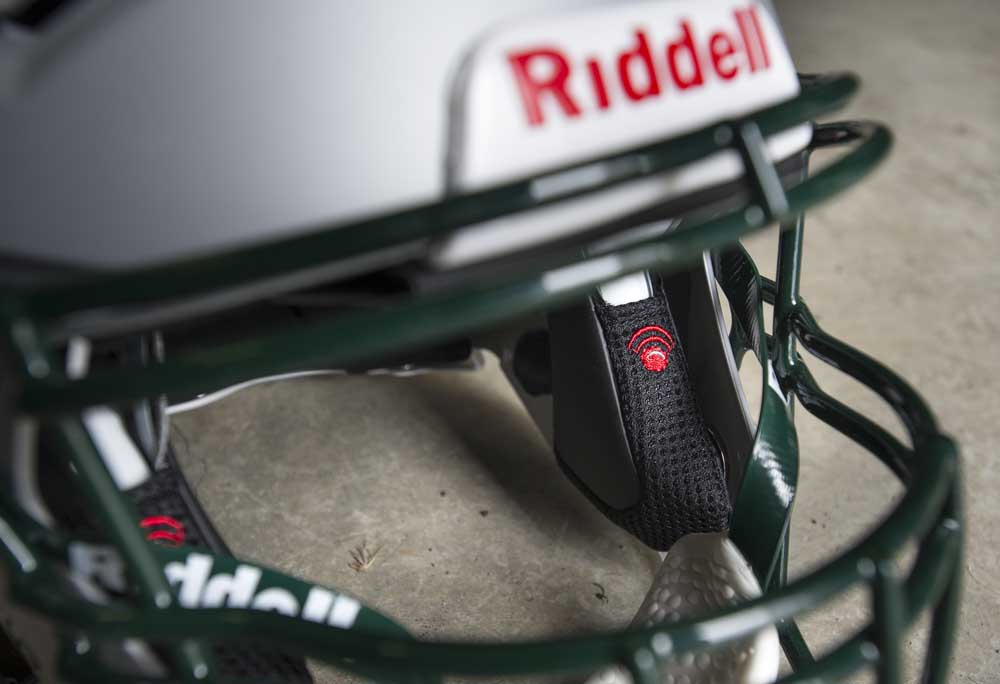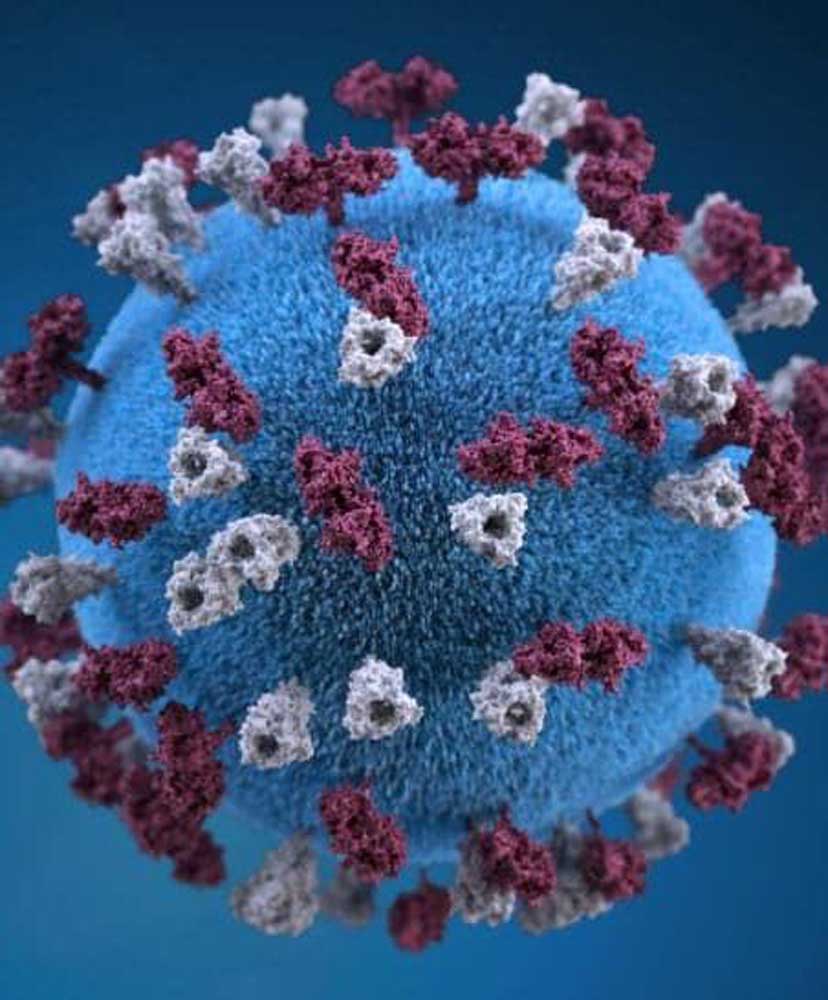Rising concussion awareness leads one high school to invest in high-tech football helmets
Published 12:00 am Sunday, April 22, 2018

- A small red logo is one of the only ways to tell the difference between a standard football helmet and a Riddell impact-monitoring one. The helmets have onboard electronics that evaluate each impact that occurs during a game or practice and sends an alert to a monitor when impact thresholds are exceeded.(Ryan Brennecke/Bulletin file photo)
Corben Hyatt recalls his high school and college football playing days with fondness.
Sure, football is a grind: the two-a-days in relentless heat, the bruises of battle on the gridiron, the exhaustion at the end of each practice and game. But the rewards of all that agony — valuable lessons in teamwork, accountability and work ethic — are what Hyatt remembers best.
That is why Hyatt, the head football coach at Bend’s Summit High School, is emphatic about his mission.
“We’ve got to protect this game,” said Hyatt. “We don’t want to see the game go away.”
To that end, Hyatt has spearheaded a $20,000 investment by the Summit program that he believes will help keep football alive: Beginning next season, Summit players will be equipped with helmets that monitor the severity of hits and potential concussion risk. The move is meant to combat declining participation in football in the wake of rising awareness of the damage repeated concussions can cause to the brain.
“We’ve all read the articles about concussions, and the game’s kind of under attack,” Hyatt said. “I was like, ‘OK, we’ve got to start thinking outside of the box here.’”
“One of the big things, selfishly, as a coach, we’ve got to increase participation. We’ve got to figure out how to do that. What’s the biggest question we all get asked as coaches? Concussions. What are we doing to protect our kids?”
In recent years, football has taken a hit in participation in most parts of the country. From 2012 to 2017, the number of children participating in the Bend Park & Recreation District tackle football league dropped by more than one-third while many other park district youth sports programs saw numbers rise. The decline can be largely attributed to growing awareness of brain injuries and published studies spotlighting the danger of concussions. According to recent research by Northwestern University, the number of diagnosed concussions among football players in the United States doubled between 2005 and 2015.
That spike is thought by researchers to be due to laws enacted by all 50 states in 2010 that set guidelines for when to remove an athlete from play after a suspected head injury and when those athletes are allowed to return to action. That legislation added to increasing awareness — and perhaps heightened fear — of concussions in football.
“So I started wondering: ‘What it is we need to do,’” Hyatt said. “Do we coach differently? Is there better equipment out there?”
Summit finds innovation
Hyatt believes he has found that better equipment: Riddell SpeedFlex helmets with InSite Training Tool, billed by the Illinois-based sports equipment company as state-of-the-art protection for football players. A five-zone sensor pad embedded in the interior of the helmets collects data from each practice and game, and that data is displayed on an online interactive platform, allowing coaches to view the severity of hits. Coaches will have impact monitors that alert them in real time if a hit could be considered dangerous.
This technology takes coaching to a different level, Hyatt said. After all, it is one thing for blocks and tackles to be observed during action, Hyatt said, but football becomes a different ballgame when the actual impact — and potential repercussion — of those hits can be almost instantly monitored and analyzed.
Players “earn their Flex,” according to Hyatt, by participating in a weightlifting class or joining the team’s morning workouts, maintaining at least a 2.5 GPA and volunteering in one of the program’s summer community service programs.
Each player who is assigned a helmet will have what is called an impact profile. The player’s height, weight and position will be entered into the system by Summit coaches, and each hit throughout the season will be compiled in each profile.
The system, according to Riddell — one of the most prominent manufacturers of football helmets at any level, including the NFL — “analyzes each profile to identify training opportunities that may decrease head impact exposure.”
“I can use that as a coaching tool,” said Hyatt, who will be in his second season as the Storm’s head coach in 2018 after serving as an assistant coach at Summit for five years. “Maybe it’s a kid turning his head when he’s taking a blow. Is he getting struck on the side of the head at a certain time? It’s going to tell us that it might not be the big hit (that results in a concussion). Or it could be the repetitive hits, the small, little hits that keep adding up.
“It’s never bad to have more information.”
Hyatt expects to have plenty of information next year, as the coach will upload each helmet’s collected data after games. He can view the calculated force and the frequency of blows to the head for each player. The information will allow Hyatt to possibly alter Summit’s way of coaching drills and could provide insight into how frequently players are receiving blows to the head — and into the severity of those blows.
Riddell said Summit joins Centennial of Gresham, Hood River Valley, Lincoln of Portland and Valley Catholic of Beaverton as the only high schools in Oregon that will be using InSite. No colleges in the state will be using it.
Nationwide, more than 30,000 players in more than 1,000 programs, including 100 collegiate programs, will be outfitted in Riddell’s InSite technology, which was made available to the public in 2014 and, based on coaches’ feedback to the company, has become one of the more reliable resources in football, according to Devin Hamrick, associate business and marketing manager for Riddell IQ, the company’s “smart helmet” division.
Several other manufacturers, such as the newly launched VICIS, also have helmets with technology that detects blows to the head.
“You want accurate and valid data,” said Hamrick. “The way the InSite sensor system is designed, there has to be an impact for (hits) to be recorded. With some other technologies, oftentimes helmet movement can be recorded as impact based on how systems record their data. Ours, you can’t have a false positive because the way our sensor works, it has to have an impact being sensed to spit out a data point.”
The purpose of the technology, Hamrick continued, is to allow coaches to adjust drills and training to minimize head injuries and help football adapt to a world of concussion concerns. If the game did not adapt, he said, “they would have kept doing things the way they’ve always done it. It’s hard to progress if we don’t evolve.”
Thinking outside the box
Hyatt said he is eager to be at the forefront of this evolution. In a way, he already is. When Oregon State University staged a week of preseason practices at Summit High last summer, Hyatt noticed certain players were wearing padded helmets called Guardian helmet caps (picture the inside padding of a helmet covering the helmet’s outer shell). Hyatt spoke with OSU’s equipment staff and learned that those pieces of equipment help reduce the impact of tackles. As of last season, Summit’s linemen, tight ends, linebackers and fullbacks wear one of the team’s 22 new Guardian helmet caps during practices.
That was an example of Summit thinking outside the box, Hyatt said, recalling the interview process that led to his promotion to head coach, during which Summit athletic director Gabe Pagano expressed that the football program should be innovative. After noticing during the 2017 season that some of the program’s equipment needed to be updated — particularly the helmets (the last significant purchase of new helmets, Hyatt said, was in 2009) — the Storm’s new coach began researching the latest gear. Manufacturers strongly recommend that all helmets be removed from use when they reach their 10-year lifespan. Hyatt eventually settled on the high-tech Riddell helmet.
Hyatt said he spoke with a Riddell representative and collected cost and product information. The coach then created a proposal for Summit High’s administration, who were sold on the technology and innovation of the helmets, Hyatt said. Hyatt negotiated a two-year payment plan with Riddell for the purchase of 44 new helmets and 16 existing helmets that were retrofitted with the InSite program. Hyatt estimated that, including reconditioning of the used helmets, the bill would run the program more than $20,000. He said the Summit football program would be responsible for most of the cost, though the school, by directing money saved elsewhere in its school budget, will chip in where it can.
While the Storm will be ahead of the game with the new technology, Bend, Mountain View and La Pine high schools said they have no plans to update their helmets. A major purchase like the one Summit has made could raise eyebrows in the community, but both Pagano and Sal Cassaro, the school district athletic coordinator, confirmed that the school budget decision was Summit’s to make.
“This is our year that we were losing a whole bunch of (aging) helmets so that had to be built into this year’s budget,” Pagano said. “I sure hope there wouldn’t be backlash. This generation of football helmets provided an option for additional technology and safety. On the next go-round of helmet purchasing, I hope our budget would allow me to purchase with the same philosophy in mind.”
Cassaro explained that each school within the district has its own school budget. If a school saves money in certain areas, it can reallocate those savings to a specific purpose, as Summit did with its new football helmets. The purchase, Cassaro said, did not require school district approval. He did note that Summit’s investment could ruffle some feathers in the community — why is student athlete safety seemingly emphasized more at one school than at others? — but for those who work in the school district, “I don’t think that’s going to be an issue because they know how it all gets played out. They know there’s equity in funding, and that’s what’s at the forefront.”
“Schools are funded equally,” Cassaro continued. “Sometimes, schools are able to save so they can purchase a special item later on. I think anybody who listened to that would understand why Summit was able to purchase these (helmets) the way they did.”
Paying for the new helmets will be stressful, Hyatt said. He assured that no donor to the Summit program is cutting him a check for the helmets, such as in 2007 when former NFL quarterback Drew Bledsoe, a Summit assistant coach, led a fundraising effort to install an artificial turf field at the high school. If need be, he said, the Storm will be hosting car washes and bake sales until the debt is paid in full. Still, he said it is comforting to know that his program offers a product that could potentially help revitalize the sport Hyatt loves.
“I want the game around,” Hyatt said. “If it needs to adapt and change, we need to do that. There’s only a certain amount of hits you have in your body. … If (the acquisition of new high-tech helmets) does what I think it’s going to do — increase participation, take care of our kids, another layer of safety for these kids — I would love to have it in every helmet.”
—Reporter: 541-383-0307, glucas@bendbulletin.com.








